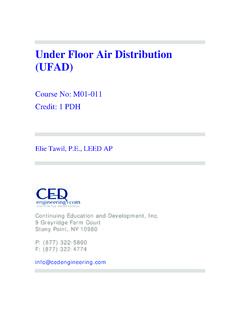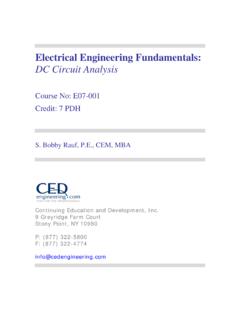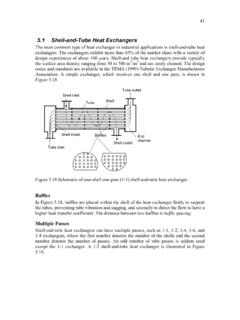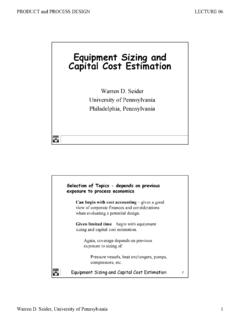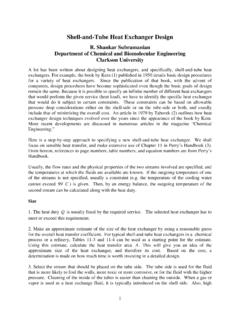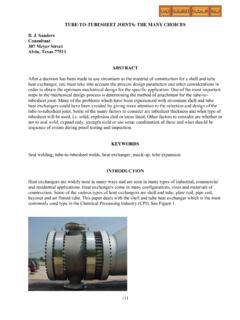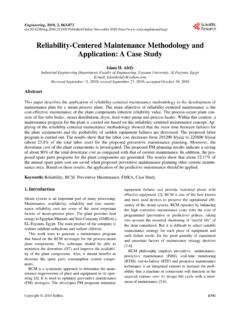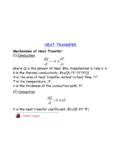Transcription of Heat Rejection Options - CED Engineering
1 heat Rejection Options in HVAC Systems Course No: M04-029 Credit: 4 PDH A. Bhatia Continuing Education and Development, Stonewall CourtWoodcliff Lake, NJ 07677P: (877) Rejection Options IN HVAC SYSTEMS Air conditioning systems captures the heat energy from within the environment and rejects it to the environment using air or water as the medium. Where there is an available, relatively inexpensive water supply, the typical equipment used is a wet cooling tower. The cooling tower circulates water to the shell and tube condenser, where the water absorbs heat from the condensing refrigerant and is then returned to the cooling tower where it falls through a media while subjected to a cross-flow or counter-flow current of ambient air, forced or induced through the cooling tower by a fan.
2 Other condenser cooling/ heat Rejection Options include evaporative cooling, which is similar to the cooling tower process, except evaporating water is used directly to cool the condenser. Evaporative cooling allows the condenser to operate at slightly lower temperatures and higher efficiencies compared to cooling towers. If water is not available or if the cooling system operates on a minimal number of hours, heat Rejection can be accomplished with ambient air using a finned coil condenser. A typical air cooled condenser has the hot, high-pressure refrigerant vapor flowing through the tubes of a finned-tube heat exchanger and uses propeller-type fans to draw outdoor air over the outer surfaces of the tubes and fins.
3 In order to properly apply the heat Rejection concepts, HVAC designer must be aware of the different heat Rejection methods. In this course we will discuss the various heat Rejection methods as well the controls that may be used to maintain proper refrigerant and water temperatures. Also presented in the course is the concept of total heat of Rejection , its derivation and how it applies to the process of air conditioning. PART -1 VARIOUS METHODS OF heat Rejection There are five prominent ways of heat Rejection : 1.
4 Air cooled condensing units 2. Closed circuit coolers 3. Evaporative condensers 4. Cooling Towers 5. Adiabatic condensers Background It is important to understand what heat of Rejection is before discussing the selection of appropriate method, equipment or technology. heat of Rejection is the energy removed from a refrigerant in the condensing process. Hot gaseous refrigerant enters the condenser where it loses its latent heat of evaporation to become hot liquid refrigerant. That process occurs regardless of the method adopted to absorb the heat rejected.
5 In typical terms the heat of Rejection is some 15% to 25% greater than the cooling effect in the evaporator. This is because the heat of compression is added into the system. The actual percentage that occurs depends upon a number of factors including the suction temperature and the discharge temperature. Low suction temperature and/or high discharge temperature increases the percentage. As an example: Standard selection for reciprocating compressor operating on HCFC-22 is usually 40 F saturated suction and 105 F condensing temperature.
6 The heat of compression at this condition is typically If the same compressor operates at 40 F saturated suction and 120 F condensing temperature, the heat of compression shall be and if it operates at 30 F saturated suction and 105 F condensing temperature, the heat of compression shall be The selection of refrigerant has little impact upon the percentage result. Further factors in the control of a refrigeration system are superheat and sub-cooling. Superheat is the extra heat added to the refrigerant vapor beyond what is required to vaporize all of the liquid.
7 Superheating ensures total evaporation of the liquid refrigerant before it goes into the compressor. While some amount of superheat is required to protect the refrigeration system and prevent liquid entering the compressor, too much superheat can cause high operating temperature at compressor and consequent oil breakdown and increased system downtime. Super heat also contributes to increase in the total heat of reject at the condenser and it should be in the order of F for system protection. Sub-cooling is the process of cooling condensed gas beyond what is required for the condensation process.
8 Sub-cooling can have a dramatic effect on the capacity of a refrigeration system - as a general rule; a 1% increase in refrigeration capacity can be achieved for every 2 degrees of liquid sub-cooling. Due to this characteristic, designs of condensers have been changed to achieve liquid sub-cooling. Sub-cooling is best accomplished in a separate sub-cooler or a special sub-cooling section of a condenser because tube surface must be submerged in liquid refrigerant for sub-cooling to occur. In an air cooled, adiabatic and evaporative condenser, a secondary coil is used to achieve the sub-cooling.
9 A good sub-cooling is about 10 F. Condensing Temperature: The condensing temperature is the temperature at which the refrigerant gas will condense to a liquid, at a given pressure. It should not be confused with the discharge temperature, which is the temperature when the superheated gas leaves the compressor. Air cooled condensers normally requires between 125 F to 130 F condensing temperature to reject heat to a 100 ambient, while a water cooled condenser can operate at 105 F condensing temperature and reject its heat to a 95 F water stream.
10 The discharge temperature is of the order of 165 and is not the same as the condensing temperature although the pressure is the same. Condensers are rated in terms of total heat Rejection (THR), which is the total heat removed in de-superheating, condensing and sub-cooling the refrigerant. Condenser Total heat of Rejection (THR) Total heat of Rejection (THR) is equal to net refrigeration effect (RE) at the evaporator (compressor capacity) plus the energy input into the refrigerant by the compressor ( heat of compression).

